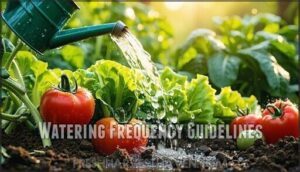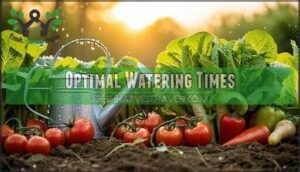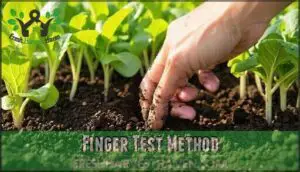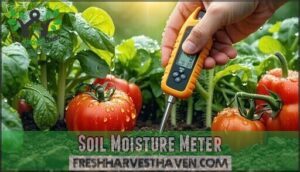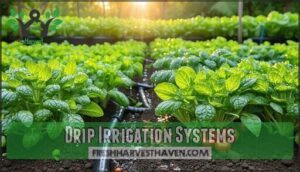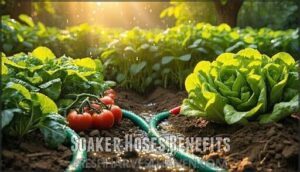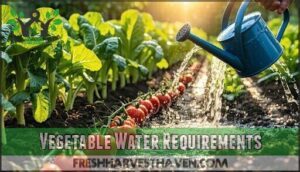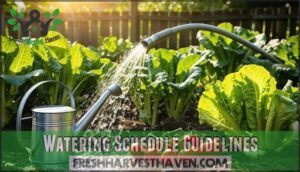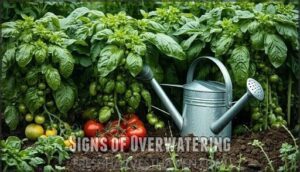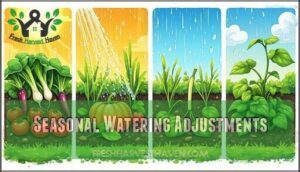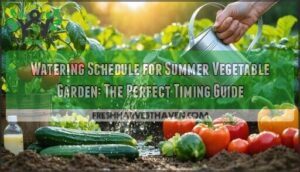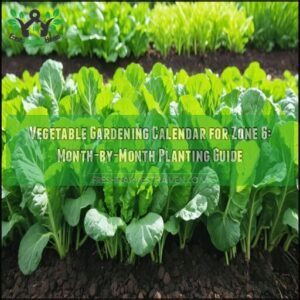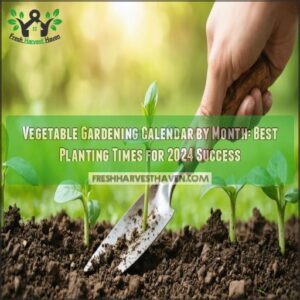This site is supported by our readers. We may earn a commission, at no cost to you, if you purchase through links.
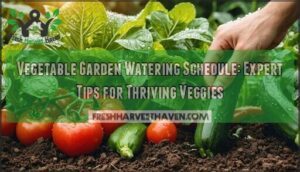 A solid vegetable garden watering schedule keeps your plants happy and you stress-free.
A solid vegetable garden watering schedule keeps your plants happy and you stress-free.
Aim to water deeply a couple of times a week—not just a quick sprinkle.
Early mornings work best since the sun won’t steal all the moisture.
Use your finger as a secret weapon: poke the soil an inch deep; if it feels dry, it’s time for a drink.
Sandy soils dry fast, while clay holds water longer, so adjust for your garden’s personality.
Overwatering leads to yellow leaves and root rot, so don’t smother your veggies with love.
Curious if mulch or drip irrigation makes a difference?
Table Of Contents
- Key Takeaways
- Soil Preparation Basics
- Watering Frequency Guidelines
- Optimal Watering Times
- Assessing Soil Moisture
- Efficient Watering Techniques
- Vegetable Water Requirements
- Watering Schedule Guidelines
- Signs of Overwatering
- Seasonal Watering Adjustments
- Frequently Asked Questions (FAQs)
- How frequently should you water a vegetable garden?
- How long should I run my sprinklers on my vegetable garden?
- How often should I water my vegetable garden during drought?
- When should you water a vegetable garden?
- How do you water a vegetable garden?
- How much water do vegetables need a week?
- How do you know when to water a vegetable garden?
- How often should you water a raised vegetable bed?
- How often should I water my Garden?
- Is it better to water your garden at night or in the morning?
- Conclusion
Key Takeaways
- Check your soil before watering; if it feels dry two inches down, it’s time for a deep drink.
- Water early in the morning so roots soak it up and leaves dry fast, preventing disease.
- Adjust your watering schedule for your soil type and local weather—don’t just water on autopilot.
- Mulch and drip irrigation keep moisture in the soil and save you time and effort.
Soil Preparation Basics
Starting with healthy soil makes growing vegetables much easier, since good soil holds water well, helps roots grow deep, and keeps plants strong.
Healthy soil is the secret to thriving veggies—strong roots, steady growth, and unbeatable water retention start right beneath your feet.
Just a little time spent mixing in compost and checking your dirt can save you headaches when summer heat hits.
Improving Water Retention
You’ll quickly notice better soil moisture retention when you work in organic amendments like compost, aged manure, or even water crystals.
Healthy, rich soil holds every drop—thanks to compost and aged manure, your garden drinks deep and stays lush.
These soil amendments for water retention tighten up sandy soils and help clay incorporation so water hangs around, not just rushes through.
Soil compaction? Fight it with mulching and regular organic amendments.
Mulch types matter, too—straw, wood chips, or leaves all help.
Mulching acts as a moisture-preserving blanket, slashing evaporation by up to 70%.
With every effort, you’re building a solid water-retaining foundation, using organic amendments.
Suppressing Disease
One big way to cut down on foliar diseases is to keep leaf wetness to a minimum—water at the soil level, not over the leaves.
Good air circulation and healthy soil go hand in hand with smart watering techniques, helping your plants become more disease resistant.
Watch out for overwatering signs, like yellowing leaves, and underwatering signs, such as drooping.
Sticking to a steady vegetable garden watering schedule guides roots deep, reducing disease risks and keeping your veggies healthier all season.
Enhancing Nutrient Content
If you want your vegetable garden watering schedule to go the distance, beef up your soil’s nutrient content from the start.
Sprinkle in compost, try Compost Tea, or sow Cover Crops and Green Manure to boost soil microbes and fertility with every watering.
By doing this, you’ll:
- Cut back on synthetic NPK fertilizers
- Boost plant immunity and ward off pests
- Keep nutrients cycling for steady, healthy growth
A quarter-inch of compost each season and mixing in Bone Meal means your watering schedule supports root health while giving plants the steady nutrition they crave.
Watering Frequency Guidelines
Knowing how often to water your vegetable garden can make the difference between wilted leaves and thriving plants, especially when the weather changes.
You’ll get better results by matching your watering routine to your soil type, climate, and the needs of different veggies.
Climate Considerations
How does climate mess with your vegetable garden watering schedule?
Regional rainfall, temperature impact, humidity levels, and seasonal changes all play a part.
In hotter weather, water evaporates quickly—so bump up your watering by about half an inch for every 10°F rise above 60°F.
Microclimates and sudden heatwaves can sneak up, so don’t just rely on a fixed plan; check soil moisture daily during extreme weather conditions.
Gardeners should also consider adjusting irrigation timers as temperatures cool.
Soil Type Factors
After considering your climate, you’ll find soil type has a bigger say in your watering routine.
Each patch of earth brings its own personality to the garden party—sometimes much thirstier than you’d expect!
- Sandy soil acts like a leaky bucket—water runs right through, so you’ll water more often.
- Clay soil holds onto moisture tightly, risking soggy roots if you’re not careful.
- Loamy soil is the Goldilocks of soil types—just right for water retention and drainage.
- Amended soil lets you water deeply, less often.
Plant Type Variations
Every plant type in your vegetable garden has its own watering personality.
Leafy Greens like lettuce crave consistent moisture, needing shallow, regular drinks to avoid wilt.
Root Vegetables—think carrots or radishes—depend on steady moisture, but not soggy soil, for strong roots.
Fruiting Plants such as tomatoes and peppers like deep, less frequent watering, so roots grow deep and strong.
Don’t lump Herbs or Beans with these; each vegetable variety comes with vegetable-specific watering needs for best harvests.
Remember that vegetables generally need about one inch weekly to thrive.
Optimal Watering Times
Choosing the right time to water your vegetable garden can make a big difference in how healthy your plants grow.
You’ll save water and help prevent diseases when you time your watering just right.
Early Morning Benefits
Start your day with early morning watering—your plants will thank you. This is the best time to water your vegetable garden because cool dawn air slows Evaporation Reduction, so roots drink it all in.
Morning watering leaves plenty of time for leaves to dry, which means stellar Disease Prevention later. One key is to implement efficient water delivery using soaker hoses.
Stick to a Consistent Timing routine. You’ll see Maximized Uptake, stronger growth, and a reliable watering schedule will soon feel second nature for both you and your plants, leading to overall efficient garden care.
Avoiding Midday Watering
Under the hot midday sun, watering your garden is like trying to fill a bucket with a hole—most of the water escapes as Evaporation Reduction works against you.
Up to 30% of moisture is lost, which leads to Water Waste and can crank up the chances of Leaf Burn and Root Stress.
Aim for early morning watering instead; that’s the best time to water for ideal Plant Health.
Adjust your watering schedule and techniques to skip midday, letting your plants focus on growing, not surviving.
Evening Watering Considerations
Convenience tempts many to water their gardens after sundown, but beware—nighttime moisture comes with baggage.
Wet leaves linger, boosting disease risk like a magnet for fungal spores. The drop in soil warmth at night can slow roots, and those dark, damp hours are practically an open invitation for slugs.
- Leaf Wetness increases overnight, raising fungal issues
- Cooler soil raises Temperature Impact on root growth
- Higher Slug Activity targets your veggies
- Risk of root rot soars with lingering moisture
Stick to smart watering techniques and review your garden watering schedule for best results.
Assessing Soil Moisture
Knowing when your plants need water starts with checking the soil. You’ll get better results if you learn how to spot dry soil before your veggies start to droop.
Finger Test Method
In regards to gauging your vegetable garden’s watering needs, the finger test is as simple as it gets.
Just slip your finger into the soil up to your second knuckle—about 2 inches deep.
You’ll get an accurate moisture reading right where the roots grow.
If it’s dry at that soil depth, it’s time to water; if the soil feels cool or slightly damp, you can wait a bit.
Consistent checks keep watering frequency in check, helping you avoid overwatering and its risks.
Here’s a helpful cheat sheet:
| Soil Type | Finger Test Feeling | Watering Needed? |
|---|---|---|
| Sandy | Dry, gritty | Yes, immediately |
| Loamy | Slightly damp | Not yet |
| Clay | Cool, sticky | No, wait |
| Mulched | Dry on top only | Check deeper |
Following this finger test, you encourage healthy plant growth and maintain soil moisture exactly where it counts.
Soil Moisture Meter
With a soil moisture meter in hand, you’ll leave guessing behind and welcome science into your garden routine.
This tool tests soil moisture levels right at the root zone, boosting Meter Accuracy and giving you a clear picture for soil moisture management. Moisture meters come in all shapes—digital and analog Sensor Types—fitting every garden style.
Don’t forget Calibration Needs to keep your readings sharp, and some meters even offer Data Logging for tracking trends. Consider different meter options for your specific needs.
They’re affordable, so here’s how to use one for reliable results:
- Push the probe 4-6 inches into the soil near your plant’s roots.
- Wait 30 seconds.
- Clean the probe after use.
Checking for Dryness
Don’t let guesswork throw off your watering game. Try a deep soil check—dig about 2 inches below the surface, move aside mulch for accuracy (mulch interference is sneaky), and squeeze the soil.
If it forms a loose ball, moisture levels are good. Flaky, powdery soil spells dryness. Watch for visual plant cues like wilting, but always recheck in the evening—sometimes plants fake it.
To guarantee healthy plant health, consider adjusting soil conditions based on early June soil pH tests. Need a quick tip for containers? Dry, shriveled surface means it’s time to water.
| Test | What to Look For | Watering Tips |
|---|---|---|
| Deep Soil Check | Forms ball when squeezed | Hold off, moisture’s good |
| Mulch Interference | Mulch feels dry | Always move before testing |
| Container Dryness | Shriveling or cracks | Water right away |
| Visual Plant Cues | Limp leaves mid-day | Wait, reassess by evening |
| Soil Moisture Levels | Powdery, flaky soil | Add water, especially in heat |
Efficient Watering Techniques
You want your vegetables to get the most water with the least effort.
Efficient watering methods like drip irrigation, soaker hoses, and mulching can help.
By using the right tools and techniques, you’ll keep your plants healthy while making the most of every drop.
Drip Irrigation Systems
After you’ve checked your soil moisture, it’s time to think about drip irrigation.
A well-designed drip system delivers water right to your plants’ roots, cutting down on waste from evaporation.
These watering systems are easy to control and offer precise water application techniques.
For best results, run your drip irrigation for 45-60 minutes weekly in spring or fall, and twice a week in summer.
Installation and maintenance are simple, cost-effective, and adaptable to almost any water source.
Drip system benefits truly make garden irrigation straightforward.
Drip irrigation is known for its high water efficiency (high water efficiency).
Soaker Hoses Benefits
A soaker hose is a steady hand in your vegetable garden watering plan.
By delivering slow watering right at the roots, it guarantees even distribution in dense gardens and cuts down waste minimization.
This keeps your watering schedule simple and your plants happy.
Because the hose waters deeply and keeps leaves dry, you’re practicing fungal prevention without lifting a finger.
This watering technique is gentle on young sprouts and keeps the focus on roots, not weeds or evaporation.
Many gardeners find reliable soaker hoses essential for their watering needs.
Mulching Advantages
Think of mulching as your secret weapon for better Moisture Retention and Soil Health.
A 2-3 inch layer of organic mulch acts like a shield, locking in soil moisture and cutting down how often you need to water.
You’ll also notice fewer weeds thanks to strong Weed Suppression, steadier Temperature Regulation, and better Pest Control.
Over time, mulching improves water retention, helps with erosion, and keeps your vegetable garden watering routine simple and effective.
Vegetable Water Requirements
Every vegetable has its own thirst, and knowing exactly how much water to give each one helps your garden stay healthy.
If you follow a few simple watering rules, you’ll see strong plants and better harvests.
Tomato Watering Needs
After setting up smart watering techniques, it’s time to focus on tomato watering needs in your vegetable garden.
Tomatoes crave consistent moisture, especially when young, so aim for about 1-2 inches per week.
Water deeply once or twice weekly—this watering schedule keeps blossom-end rot and fruit splitting at bay.
Good soil drainage and mulch help your tomato varieties thrive, making juicy fruits the envy of your neighbors.
Check two inches below the soil surface; if it’s dry, it’s time to water again.
Remember, steady water beats frequent sprinkles for healthy tomato growth.
- Prevent blossom-end rot with steady moisture
- Deep watering supports strong roots
- Mulch helps lock in water
Cucumber Watering Needs
When summer heat turns up, cucumber Thirst is real—don’t let them dry out.
Offer at least 3 gallons per week, aiming for deep, consistent moisture so roots dig 6-8 inches deep. If you spot Blossom Drop, Fruit Bitterness, or Leaf Wilting, it’s your plant’s SOS.
Cucumber watering isn’t a guessing game; follow a steady vegetable garden watering schedule. Meeting these watering needs keeps your vegetable garden healthy and your cucumbers crisp.
| Symptom | What It Means | What To Do |
|---|---|---|
| Blossom Drop | Water stress | Water deeply, regularly |
| Fruit Bitterness | Inconsistent water | Stay on schedule |
| Leaf Wilting | Dried roots | Check soil moisture |
Pepper Watering Needs
Picture yourself tending rows of pepper varieties—these plants like balance. Aim to give them 1 to 2 inches of water weekly to meet their pepper watering needs.
Consistency is everything if you want to keep blossom-end rot at bay. Focus on the root zone, making sure your soil drainage is solid to avoid soggy roots.
Container peppers dry out faster, so check them more often. Push your finger two inches deep into the soil before watering.
This simple vegetable garden routine helps you master your vegetable-specific watering needs, ensuring you maintain the right conditions for your plants, like providing the necessary water.
Watering Schedule Guidelines
Knowing when and how much to water keeps your vegetable garden healthy, no matter what the weather brings.
These simple schedule tips will help you give your plants just what they need, right on time.
General Schedule Overview
No two gardens are exactly alike, but most vegetable gardens thrive with a weekly average of 1–2 inches of water, spread over 1–3 deep sessions instead of daily sprinkles.
Let your soil type set your rhythm—sandy ground dries fast and needs more attention, while clay holds moisture longer.
Adjust your vegetable garden watering schedule as plants mature, keeping an eye on changing growth stages and watering needs for consistent, healthy veggies, and ensuring you have a well-planned rhythm.
Adjusting for Weather
When the weather takes a sharp turn, your watering schedule needs to pivot too.
Temperature effects, humidity levels, and sunlight intensity can all drain soil moisture faster.
Don’t treat every week the same—watch for these signs:
- Hot, sunny days demand extra care to avoid parched plants.
- After rainfall, use the finger test to check for soaked ground before watering again.
- Windy spells call for closer soil checks and maybe extra water.
Adjust with confidence as weather conditions shift.
Seasonal Considerations
Just as you’ve learned to watch the skies for sudden storms or dry spells, you’ll also adjust watering as seasonal changes roll in.
Kick things off in spring—the "spring increase"—by slowly boosting moisture while roots settle.
When summer peaks and temperatures soar, plants drink faster; check soil daily during heatwaves.
By fall, begin your "fall decrease" as temperatures cool and rainfall picks up.
In winter dormancy, water sparingly, always remembering to factor in regional variations and local climate considerations for best results and to adjust according to the "seasonal changes" for optimal care.
Signs of Overwatering
You might think extra water helps your garden, but too much can hurt your plants.
Watch for yellowing leaves, soggy soil, or droopy stems, which may mean you’re watering a bit more than your veggies need.
Root Rot Risks
Root rot can sneak up on even the most attentive gardeners, often revealing itself as brown, mushy roots instead of crisp, white ones.
Overwatering signs like soggy soil and poor drainage set the stage for trouble. Check soil moisture before watering—if it feels wet two inches down, skip it.
Embrace soil aeration and improve drainage importance to fend off fungal diseases. Plants prefer slight dryness, so preventing root rot means avoiding soil saturation and letting roots breathe to improve overall health and prevent fungal diseases.
Fungal Disease Signs
Now and then, if you overdo your vegetable garden watering, fungal diseases like powdery mildew and leaf spot creep in quickly.
You’ll spot white, powdery coatings on leaves, yellow halos around dark spots, or brown mushy stem rot down by the soil.
Sometimes fruit spots show up too, as if your tomatoes caught a cold.
Stick to proper watering techniques and keep air moving between plants to outsmart foliar diseases and keep your watering schedule on track.
Yellowing Leaves
A patch of yellowing leaves can make any gardener uneasy.
You might think it’s Nutrient Deficiencies, Disease Impact, Pest Infestation, or even Improper pH or Light Exposure.
But often, yellowing leaves mean your vegetable garden watering routine needs adjusting.
If your watering schedule leaves soil constantly soggy, roots can’t breathe.
They start struggling to absorb nutrients, a bit like us trying to breathe underwater.
Always check if leaves feel soft or limp before you water again.
Meeting your plant needs begins with diagnosing yellowing leaves properly.
Organic Matter Addition
Adding organic matter is a simple, powerful fix when your garden suffers from too much water.
Mix in compost or well-rotted manure—two proven Manure Types—to boost soil fertility and structure.
You’ll tap into real Compost Benefits, like improved drainage and stronger soil aeration, which help guard against waterlogging.
Consider organic soil amendments or even polymers for added water retention in sandy beds.
With regular use, your soil recovers faster, holds water better without flooding, and sets your veggies up for healthy growth in every season with improved drainage.
Mulching Benefits
Ever felt like your garden’s always thirsty?
Mulching steps in as your garden’s water-saving sidekick.
Throw on a layer of organic mulch, and you’ll lock in moisture, keep the soil cool, and cut back on watering chores.
Mulching means less weeding, too, thanks to superior weed suppression.
It’s like giving your soil a hat—shielding roots from harsh sun and stopping erosion in its tracks.
Over time, organic mulch boosts soil health, keeping your veggies strong and your life easier, with benefits like superior weed suppression.
Soil Structure Enhancement
A sturdy foundation starts with good soil structure—it’s the backbone of water management in your vegetable garden.
Without it, you might end up with puddles, parched roots, or endless frustration.
Here’s how you can level up your garden with smart soil amendments:
- Clay Amendment: Mix in compost or organic polymers to loosen heavy clay, creating space for roots and drainage.
- Sandy Improvement: Improve sandy soils by working in plenty of compost, boosting soil quality and moisture retention.
- Double Digging & Aeration Benefits: Break up compacted layers for better aeration, which prevents root rot and fosters healthy growth.
Dial in your soil composition for balanced soil texture and flourishing veggies.
Seasonal Watering Adjustments
You’ll need to adjust your garden’s watering schedule as the seasons change, since vegetables require more water in hot months and less when it’s cooler out.
By keeping an eye on temperature and rainfall, you can make sure your plants get just the right amount, all year long, which is crucial for their health and development.
Spring and Summer Needs
When spring rolls in, your watering schedule shifts gears.
Warmer days and rapid peak growth mean your vegetable garden’s watering needs rise quickly.
Keep an eye out for heat stress and problems like blossom end rot.
Check soil moisture every morning, especially when watering frequency spikes in summer.
Watering deeply, preferably at sunrise, helps you beat the heat while saving water.
Remember to take into account soil stickiness tests to accurately gauge moisture levels.
Here’s a quick comparison:
| Season | Watering Frequency |
|---|---|
| Spring | 2-3 times a week |
| Summer | Daily for seedlings |
| Morning Check | Always |
| Afternoon | Avoid if possible |
Fall and Winter Reductions
As autumn leaves start to fall, your watering schedule changes, too.
With reduced evaporation and plants slipping into dormancy, watering needs drop for your vegetable garden.
For overwintering crops, check soil moisture about 2-3 inches deep—water only if it’s dry.
Keep these points in mind:
- Hold off watering before a frost for better frost protection.
- Apply a thick mulch for insulation.
- Seasonal rainfall usually covers most needs, so don’t overdo it.
Climate-Based Adjustments
When winter quiets down, it’s time to rethink your watering schedule for your climate.
Hot, sunny days mean higher evaporation rates and more work for you. Cool, humid places need less watering, since moisture sticks around.
Keep a close eye on rainfall patterns, temperature effects, and sunlight intensity—these drive seasonal changes.
A simple calendar that tracks weather conditions and humidity levels helps make smart seasonal adjustments, saving water and helping your veggies handle environmental changes with ease.
Frequently Asked Questions (FAQs)
How frequently should you water a vegetable garden?
Water your garden deeply about two to three times each week, letting the soil soak it up like a thirsty sponge.
If your fingers find the soil dry two inches down, it’s time for another drink.
How long should I run my sprinklers on my vegetable garden?
Did you know mulching can cut water loss by up to 70%?
To hit that sweet spot, run your sprinklers until they deliver 1 inch of water—usually 30 to 45 minutes, depending on your system’s output.
How often should I water my vegetable garden during drought?
Stick your finger two inches into the soil—if it’s dry, it’s time to water.
Shoot for deep soaks two to three times a week, ideally early morning.
Mulch helps too, shielding roots from heat and loss.
When should you water a vegetable garden?
If your plants could talk, they’d beg for a morning drink.
Hit the garden early, before the sun steals all the moisture.
You’ll dodge wilting leaves, keep roots content, and sidestep those pesky evening fungal run-ins.
How do you water a vegetable garden?
Start your day by soaking the soil early, aiming for deep roots, not soggy leaves.
Use soaker hoses or a slow pour to keep the soil moist.
Check with your finger—dry two inches down means it’s thirsty.
How much water do vegetables need a week?
Moisture matters most—most veggies thrive with about one inch of water each week.
Pour water early in the morning so it soaks the soil, not the leaves, and you’ll help roots dig deep and stay strong.
How do you know when to water a vegetable garden?
Press your finger two inches into the soil—if it feels dry, it’s time to water.
Dry, cracked surfaces aren’t just unsightly; they’re thirsty!
Don’t trust wilted leaves midday—they’re drama queens and often bounce back by evening.
How often should you water a raised vegetable bed?
You should water a raised vegetable bed deeply two or three times a week, checking soil moisture first.
Stick your finger in; if it feels dry two inches down, it’s time for a drink.
Don’t drown ‘em!
How often should I water my Garden?
Wilted plants bounce back after a good soak, but soggy roots can spell trouble.
Aim for deep watering two or three times a week, not daily.
Check soil by touch—dry two inches down means it’s time.
Is it better to water your garden at night or in the morning?
Getting up early pays off—morning is the best time to give your plants a drink.
Cooler temps mean less water lost to evaporation, and leaves dry out before night, keeping disease at bay.
Your garden thrives!
Conclusion
Mother Nature sometimes skips a beat, so sticking to a reliable vegetable garden watering schedule helps keep your crops strong all season.
Remember, deep, consistent watering gets roots growing deep, not just surface-level sips.
Test your soil, adjust for its type, and don’t forget about the weather.
Mulch and smart tools stretch every drop.
Pay attention to your plants—they show what they need, and with a bit of care, your garden will reward you with healthy, thriving veggies.

